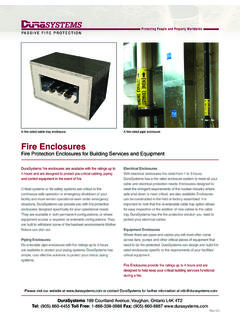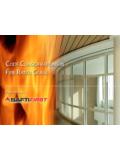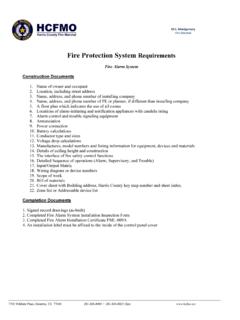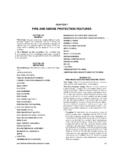Transcription of RR988 Ventilation of enclosures for removal of …
1 Health and Safety Executive Ventilation of enclosures for removal of asbestos containing materials Prepared by the Health and Safety Laboratory for the Health and Safety Executive 2013. RR988 . Research Report Health and Safety Executive Ventilation of enclosures for removal of asbestos containing materials Dom Pocock, Steve Bennett and John Saunders Health and Safety Laboratory Harpur Hill Buxton Derbyshire SK17 9JN. When removal of high-risk asbestos - containing materials takes place, the work should be carried out inside a specially constructed ventilated enclosure to prevent the spread of asbestos outside the work area. The aim of this research project was to investigate the factors that affect the containment potential of temporary ventilated enclosures . The work covered; the way that air moves within ventilated enclosures , how the construction of enclosures and airlocks affects air movement and containment, and how the positioning of extraction points and air inlets affect air movement and containment.
2 Work was done to investigate the relationship between air flow and negative pressure, and containment. The study also examined factors which affect the ability of enclosures to contain asbestos , such as unplanned openings. In addition to this the effect of removing ceiling tiles and the size of ceiling void relative to the enclosure was investigated. This report and the work it describes were funded by the Health and Safety Executive (HSE). Its contents, including any opinions and/or conclusions expressed, are those of the authors alone and do not necessarily reflect HSE policy. HSE Books Crown copyright 2013. First published 2013. You may reuse this information (not including logos) free of charge in any format or medium, under the terms of the Open Government Licence. To view the licence visit , write to the Information Policy Team, The National Archives, Kew, London TW9 4DU, or email Some images and illustrations may not be owned by the Crown so cannot be reproduced without permission of the copyright owner.
3 Enquiries should be sent to Acknowledgements The authors would like to acknowledge Richard Anderson and thank him for his invaluable help and advice. ii EXECUTIVE SUMMARY. Background Many buildings in GB contain asbestos ; this can include pipe lagging, wall insulation, fire doors, ceiling tiles, floor material , fire- and sound-proofing. asbestos fibres are often mixed with other materials such as cement, which are known as asbestos containing materials (ACMs). asbestos is classified as a category 1 human carcinogen, under GB health and safety regulations therefore exposure to carcinogenic substances should be controlled to a level that is as low as is reasonably practicable (ALARP). removal of asbestos or ACMs can release asbestos fibres, which can become airborne, a proportion of which will be respirable. Any work in Great Britain involving asbestos should be controlled in accordance with the Control of asbestos Regulations 2012 (CAR 2012).
4 The removal work should be strictly controlled using dust suppression techniques to mitigate fibre release. The prevention of the spread of asbestos fibres is achieved by the use of temporary ventilated enclosures . Guidance on the specification, construction and operation of these enclosures is currently available in the HSE guidance document HSG 247. Following the introduction of CAR 2012 HSE's guidance is due to be reviewed and rewritten. The purpose of this work was to investigate the airflow characteristics of ventilated enclosures and the factors that affect their containment potential, in order to provide robust information on which the new guidance could rely. Additional work undertaken during the project was to investigate the effect on the airflow characteristics and containment potential of ventilated enclosures during the removal of ceiling tiles.
5 Objectives Investigate the factors that affect the airflow characteristics of ventilated enclosures , these to include;. o Ventilation rate o Location of extract position o Number of airlock inlets Investigate the factors that affect the containment potential of enclosures , these to include;. o Pressure difference between the interior of the enclosure and the surrounding space ( P) and the how various factors affect it such as volume flow rate/ Ventilation rate, airlock configuration and airlock door/door opening shape and area. o Airlock door deflection and how various factors affect this such as volume flow rate, weight of door, and overlap of door and opening. o The effect of adding inlet filters in the enclosure walls. o The effect of unplanned openings in the enclosure walls on P and containment effectiveness. iii Investigate the effect upon the volume flow rate of a hired negative pressure unit (NPU) by adding ducting to the inlet and exhaust sides and also the effect of adding 90 bends to the additional ducting.
6 Investigate the effects upon enclosure containment potential in an enclosure when simulating the removal of ceiling tiles, this to include;. o The effects when voids are sealed with a volume smaller than the enclosure and unsealed voids where the volume is much greater than the enclosure . o Above assessed by measuring effects upon P, by using tracer gas to quantitatively investigate containment effectiveness and the use of smoke to qualitatively show the effects of removing ceiling tiles. Main Findings A Ventilation rate of 8 air changes per hour (ach) in enclosure 1 produced a poor vertical mixing regardless of the extraction position; this led to an effective Ventilation rate of less than 10 % of the calculated rate at high-level positions. This meant that the air at the top of the enclosure was poorly mixed with the rest of the air in the enclosure , if the top of the enclosure was treated as a separate space the Ventilation rate was less than ach.
7 This would mean that any airborne fibres could potentially remain suspended in the air for longer than the standard 1-hour Ventilation overrun. The location of the extract position had some effect upon the horizontal mixing within enclosure 1 at the lower Ventilation rate of 8 ach (384 m3h-1). Specifically NPU position 4, which was raised above floor level, produced the best mixed atmosphere at the low level sampling positions. Having two airlocks open in enclosure 1 increased horizontal mixing. A Ventilation rate of 8ach in the larger enclosure 2 produced a well-mixed atmosphere both horizontally and vertically regardless of NPU position. This showed that when considering mixing, volume flow rate is the determining factor not the air change rate. Visualisation using smoke confirmed these findings, clearly showing the stratification within enclosure 1 at 8 ach.
8 The smoke visualisation showed that when considering the clearance time of an enclosure both the degree of mixing and the Ventilation rate need to be considered. A smoke test should be carried out as a matter of course on enclosures before they are put into operation. However it should be noted that a large volume flow rate is more important in achieving a well-mixed atmosphere than NPU position or number of airlocks. The smoke visualisation was very informative in that it demonstrated the fallacy of the common belief that n ach means that smoke will be cleared in 1/n hours by showing that it can take 4 5 air changes before the air is cleared. For standard airlock chambers volume flow rates in excess of 1900 m3h-1 caused the airlock doors to impinge on the far side of the chamber, making it difficult to work inside the chamber.
9 Adding additional inlet filters to the enclosure wall was found to reduce P and the airlock door deflection. However, this approach could have other problems such as potentially compromising containment. iv P was found to be proportional to volume flow rate through the enclosure , the open area of the airlock doors, and the weight of the airlock doors. It was also found that P could vary by up to 1 Pa as the ambient temperature changed throughout a day, which is one of the reasons that P is an unreliable indicator of volume flow rate. The effect of unplanned openings in the enclosure walls upon P was investigated; only large (~2 m) vertical slits and holes with areas of 100 cm2 had a significant effect. The effect of unplanned openings upon containment potential was assessed using a tracer gas challenge in the presence of a working Class-H vacuum cleaner exhaust and without.
10 Tracer gas was detected outside of the enclosure for all of the unplanned openings tested except the small hole with an area of 4 cm2. When tested without the presence of the vacuum cleaner exhaust no tracer gas was detected outside of the enclosure for any of the unplanned openings. This indicates that in the absence of any external disturbing airflows P was sufficient to maintain enclosure integrity. Results showed that P was not a reliable indicator of containment integrity, the position of the airlock doors as airflow indicators may be a more suitable indicator. The addition of flexible ducting to the NPU with 90 bends reduced the volume flow rate by approximately 1 % per metre of duct and 2 % per 90 bend. These reductions should be taken into account when calculating required Ventilation rates for the 355 mm diameter ducting tested.















